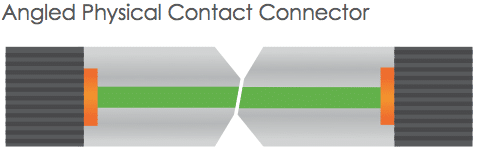UPC
Ultra Physical Contact (UPC) connector. This results in a lower back reflection (ORL) than a standard PC connector, allowing more reliable signals in digital TV, telephony and data systems, where UPC today dominates the market.
Most engineers and installers believe that any poor performance attributed to UPC connectors is not caused by the design, but rather poor cleaving and polishing techniques. UPC connectors do have a low insertion loss, but the back reflection (ORL) will depend on the quality of the fiber surface and, following repeat matings/unmatings, it will begin to deteriorate.
APC

So what the industry needed was a connector with low back reflection, that could sustain repeated matings/unmatings without ORL degradation. Step forward the Angled Physical Contact (APC) connector.
Although PC and UPC connectors have a wide range of applications, some instances require return losses in the region of one-in-a-million (60dB). Only APC connectors can consistently achieve such performance. This is because adding a small 8° angle to the end-face allows for even tighter connections and smaller end-face radii. Combined with that, any light that is redirected back towards the source is actually reflected out into the fiber cladding, again by virtue of the 8° angled end-face.
It is true that this slight angle on each connector brings with it rotation issues that Flat, PC and UPC connectors simply don’t have. It is also the case that the three aforementioned connectors are all inter-mateable, whereas the APC isn’t. So, why then is the APC connector so important in fiber optics?
The uses of APC connectors
The best feedback examples from my previous blog came from people experienced with FTTx and Radio Frequency (RF) applications. The advance in analogue fiber optic technology has driven demand for it to replace more traditional coaxial cable (copper). Unlike digital signals (which are either ON or OFF), the analogue equipment used in applications such as DAS, FTTH and CCTV is highly sensitive to changes in signal, and therefore requires minimal back reflection (ORL).
APC ferrules offer return losses of -65dB. In comparison a UPC ferrule is typically not more than -55dB. This may not sound like a major difference, but you have to remember that the decibel scale is not linear. To put that into context a -20dB loss equates to 1% of the light being reflected back, -50dB leads to nominal reflectance of 0.001%, and -60dB (typical of an APC ferrule) equates to just 0.0001% being reflected back. This means that whilst a UPC polished connector will be okay for a variety of optical fiber applications, only an APC will cope with the demands of complex and multi-play services.
The choice is even more important where connector ports in the distribution network might be left unused, as is often the case in FTTx PON network architectures. Here, optical splitters are used to connect multiple subscriber Optical Network Units (ONUs) or Optical Network Terminals (ONTs). This is not a problem with unmated APC connections where the signal is reflected into the fiber cladding, resulting in typical reflectance loss of -65dB or less. The signal from an unmated UPC connector however, will be sent straight back towards the light source, resulting in disastrously high loss (more than 14dB), massively impeding the splitter module performance.

Picking the right physical contact connector
Looking at current technology, it’s clear that all of the connector end-face options mentioned in this blog post have a place in the market. Indeed, if we take a sidestep across to Plastic Optical Fiber (POF) applications, this can be terminated with a sharp craft knife and performance is still deemed good enough for use in the high-end automotive industry. When your specification also needs to consider cost and simplicity, not just optical performance, it’s hard to claim that one connector beats the others. Therefore whether you choose UPC or APC will depend on your particular need. With those applications that call for high precision optical fiber signaling, APC should be the first consideration, but less sensitive digital systems will perform equally well using UPC.
There is no doubt that the optical performance of APC connectors is better than UPC connectors. In the current market, the APC connectors are widely used in applications such as FTTx, passive optical network (PON) and wavelength-division multiplexing (WDM) that are more sensitive to return loss. But besides optical performance, the cost and simplicity also should be taken into consideration. So it’s hard to say that one connector beats the other. In fact, whether you choose UPC or APC will depend on your particular need. With those applications that call for high precision optical fiber signaling, APC should be the first consideration, but less sensitive digital systems will perform equally well using UPC.
